Surrogate Model of Hydraulic Actuator for Active Motion Compensation Hydraulic Crane
Abstract
1. Introduction
2. The First-Principle Model
2.1. Overview of the Active Motion Compensation Crane
2.2. First-Principle Modeling of the CBV-Integrated Hydraulic Actuator
3. Surrogate Model-Based Rapid Dynamics Solution
3.1. Framework of the Dynamic Surrogate Model
3.2. Three-Hidden-Layer Neural Network-Based Surrogate Model
4. Simulation Verification of Dynamic Surrogate Model
4.1. Active Motion Compensation Hydraulic Crane Lifting System
4.2. Training and Evaluation of Dynamic Surrogate Model
4.2.1. Dynamic Surrogate Model Training
4.2.2. Surrogate Model Performance Evaluation
4.3. Solution Results and Comparative Analysis
4.3.1. Evaluation of Computational Accuracy
4.3.2. Evaluation of Computational Accuracy Under Perturbed Load
4.3.3. Evaluation of Computational Efficiency and Memory Requirements
5. Conclusions
Author Contributions
Funding
Institutional Review Board Statement
Informed Consent Statement
Data Availability Statement
Conflicts of Interest
Nomenclature
| Symbol | Meaning |
| Pressure in the oil inlet chamber of the hydraulic cylinder | |
| Pressure in the oil outlet chamber of the hydraulic cylinder | |
| Pressure control area of the balance valve | |
| Valve opening-flow area function of counterbalance valve | |
| Linear mapping bias quantity | |
| C | Hydraulic cylinder damping coefficient |
| Hydraulic cylinder equivalent damping coefficient | |
| Load force | |
| Perturbed load force | |
| The Coulomb friction force acting on the valve core of the counterbalance valve | |
| Artificial neural network surrogate model | |
| Artificial neural network surrogate model with a single hidden layer | |
| Spring stiffness of the counterbalance valve | |
| Flow coefficient of the proportional valve | |
| Flow coefficient of the counterbalance valve | |
| M | Mass of the hydraulic rod |
| Mass of the valve core of the counterbalance valve | |
| Pressure in the oil inlet chamber of the hydraulic cylinder | |
| Pressure in the oil outlet chamber of the hydraulic cylinder | |
| Pilot pressure of counterbalance valve | |
| Charge oil pressure | |
| The minimum opening pressure of the counterbalance valve | |
| Pressure change rate in the oil inlet chamber of the hydraulic cylinder | |
| Pressure change rate in the oil outlet chamber of the hydraulic cylinder | |
| Flow rate of the oil inlet chamber of the hydraulic cylinder | |
| Flow rate of the oil outlet chamber of the hydraulic cylinder | |
| Four-dimensional parameter space | |
| Two-dimensional parameter space | |
| u | Input signal of the proportional valve |
| Volume of the oil inlet chamber of the hydraulic cylinder | |
| Volume of the oil outlet chamber of the hydraulic cylinder | |
| Dead volume of the oil inlet chamber of the hydraulic cylinder | |
| Dead volume of the oil inlet chamber of the hydraulic cylinder | |
| Volume change rate of the oil inlet chamber of the hydraulic cylinder | |
| Volume change rate of the oil outlet chamber of the hydraulic cylinder | |
| x | Hydraulic rod displacement |
| Hydraulic rod speed | |
| Hydraulic rod acceleration | |
| Counterbalance valve core displacement | |
| Pre-compression amount of the balance valve spring | |
| Counterbalance valve core speed | |
| Counterbalance valve core acceleration | |
| Output layer linear mapping bias | |
| Hydraulic oil bulk modulus | |
| Pilot ratio of the counterbalance valve | |
| Output layer linear mapping coefficients | |
| Input layer linear mapping coefficients | |
| Range of parameter values | |
| Hidden layer activation function |
References
- Hao, X.; Li, J.; Ni, P.; Zhou, Z.; Chang, Z. Application of Multi-Degree-of-Freedom Motion Compensation Device in Marine Engineering. In Advances in Mechanism, Machine Science and Engineering in China; Springer: Berlin/Heidelberg, Germany, 2023. [Google Scholar]
- Salzmann, D.C.; Prezzi, J.; ten Haaf, S.; Groenteman, S. Walk to Work Offshore Using Motion Compensated Gangways; Offshore Technology Conference Brasil; OTC: Rio de Janeiro, Brazil, 2015. [Google Scholar]
- Marius, B.; Pawel, M.; Michael, G.; Paul, B. Multiple degrees of freedom active motion control of a hydraulically actuated crane. In Proceedings of the OCEANS 2021: San Diego–Porto, San Diego, CA, USA, 20–23 September 2021; IEEE: Piscataway, NJ, USA, 2021. [Google Scholar]
- Eijkhout, T.; Jovanova, J. Active heave compensation of a floating crane using electric drive. In Proceedings of the 2021 IEEE/ASME International Conference on Advanced Intelligent Mechatronics (AIM), Delft, The Netherlands, 12–16 July 2021; IEEE: Piscataway, NJ, USA, 2021; pp. 1089–1094. [Google Scholar]
- Haselsteiner, A.F.; Ohlendorf, J.H.; Oelker, S.; Ströer, L.; Thoben, K.D.; Wiedemann, K.; Ridder, E.D.; Lehmann, S. Lifting wind turbine components from a floating vessel: A review on current solutions and open problems. J. Offshore Mech. Arct. Eng. 2019, 141, 050801. [Google Scholar] [CrossRef]
- Kjelland, M.B. Offshore Wind Turbine Access Using Knuckle Boom Cranes. Ph.D. Thesis, University of Agder, Kristiansand, Norway, 2016. [Google Scholar]
- Bak, M.K.; Hansen, M.R. Analysis of Offshore Knuckle Boom Crane-Part One: Modeling and Parameter Identification; Research Council of Norway: Oslo, Norway, 2013; Volume 34, pp. 157–174.
- Nordhammer, P.A.; Bak, M.K.; Hansen, M.R. Controlling the slewing motion of hydraulically actuated cranes using sequential activation of counterbalance valves. In Proceedings of the 2012 12th International Conference on Control, Automation and Systems, Jeju Island, Republic of Korea, 17–21 October 2012; IEEE: Piscataway, NJ, USA, 2012; pp. 773–778. [Google Scholar]
- Ferreira, J.; Almeida, F.G.; Quintas, M.; Estima de Oliveira, J. Hybrid models for hardware-in-the-loop simulation of hydraulic systems Part 1: Theory. Proc. Inst. Mech. Eng. Part I J. Syst. Control Eng. 2004, 218, 465–474. [Google Scholar]
- Rituraj, R.; Scheidl, R. Towards digital twin development of counterbalance valves: Modelling and experimental investigation. Mech. Syst. Signal Process. 2023, 188, 110049. [Google Scholar] [CrossRef]
- Anders, I.P.; Ströbel, M.S.S. A New Energy Saving Load Adaptive Counterbalance Valve; Connecting Repositories: London, UK, 2016. [Google Scholar]
- Xie, H.; Liu, J.; Hu, L.; Yang, H.; Fu, X. Design of pilot-assisted load control valve for proportional flow control and fast opening performance based on dynamics modeling. Sens. Actuators A Phys. 2015, 235, 95–104. [Google Scholar] [CrossRef]
- Chu, Y.; Æsøy, V.; Zhang, H.; Bunes, O. Modelling And Simulation Of An Offshore Hydraulic Crane. In Proceedings of the ECMS, Brescia, Italy, 27–30 May 2014; pp. 87–93. [Google Scholar]
- Agúndez, A.; García-Vallejo, D.; Freire, E.; Pyrhönen, L.; Mikkola, A. An efficient and accurate linearization approach for hydraulically actuated multibody systems with holonomic and nonholonomic constraints. Nonlinear Dyn. 2023, 111, 10331–10356. [Google Scholar] [CrossRef]
- Jose, J.T.; Das, J.; Mishra, S.K. Dynamic improvement of hydraulic excavator using pressure feedback and gain scheduled model predictive control. IEEE Sens. J. 2021, 21, 18526–18534. [Google Scholar] [CrossRef]
- Alizadeh, R.; Allen, J.K.; Mistree, F. Managing computational complexity using surrogate models: A critical review. Res. Eng. Des. 2020, 31, 275–298. [Google Scholar] [CrossRef]
- Zhang, Z.; Dong, R.; Tan, D.; Zhang, B. Multi-objective optimization of performance characteristic of diesel particulate filter for a diesel engine by RSM-MOPSO during soot loading. Process Saf. Environ. Prot. 2023, 177, 530–545. [Google Scholar] [CrossRef]
- Lucay, F.A.; Sales-Cruz, M.; Gálvez, E.D.; Cisternas, L.A. Modeling of the complex behavior through an improved response surface methodology. Miner. Process. Extr. Metall. Rev. 2021, 42, 285–311. [Google Scholar] [CrossRef]
- Farzad, G.; Hui, W.; Sahel, C. A Systematic Analysis of a Small-Scale HAWT Configuration and Aerodynamic Performance Optimization Through Kriging, Factorial, and RSM Methods. J. Appl. Comput. Mech. 2024. [Google Scholar] [CrossRef]
- Wang, W.; Pei, J.; Yuan, S.; Zhang, J.; Yuan, J.; Xu, C. Application of different surrogate models on the optimization of centrifugal pump. J. Mech. Sci. Technol. 2016, 30, 567–574. [Google Scholar] [CrossRef]
- Liu, Q.; Yin, F.; Nie, S.; Hong, R.; Ji, H. Multi-objective optimization of high-speed on-off valve based on surrogate model for water hydraulic manipulators. Fusion Eng. Des. 2021, 173, 112949. [Google Scholar]
- Sarra, S.A.; Bai, Y. A rational radial basis function method for accurately resolving discontinuities and steep gradients. Appl. Numer. Math. 2018, 130, 131–142. [Google Scholar] [CrossRef]
- Lima, L.O.; Rosenberger, J.; Antier, E.; Magoulès, F. Multilayer Perceptron-based Surrogate Models for Finite Element Analysis. In Proceedings of the 2022 21st International Symposium on Distributed Computing and Applications for Business Engineering and Science (DCABES), Chizhou, China, 14–18 October 2022; IEEE: Piscataway, NJ, USA, 2022; pp. 115–118. [Google Scholar]
- Zhou, Y.; Lu, Z. An enhanced Kriging surrogate modeling technique for high-dimensional problems. Mech. Syst. Signal Process. 2020, 140, 106687. [Google Scholar] [CrossRef]
- Pan, Z.; Lu, W.; Fan, Y.; Li, J. Identification of groundwater contamination sources and hydraulic parameters based on bayesian regularization deep neural network. Environ. Sci. Pollut. Res. 2021, 28, 16867–16879. [Google Scholar] [CrossRef] [PubMed]
- Ritelli, G.F.; Vacca, A. Energetic and dynamic impact of counterbalance valves in fluid power machines. Energy Convers. Manag. 2013, 76, 701–711. [Google Scholar] [CrossRef]
- Kozlov, L.G.; Polishchuk, L.K.; Piontkevych, O.V.; Korinenko, M.P.; Horbatiuk, R.M.; Komada, P.; Orazalieva, S.; Ussatova, O. Experimental research characteristics of counterbalance valve for hydraulic drive control system of mobile machine. Przegląd Elektrotechniczny 2019, 95, 104–109. [Google Scholar] [CrossRef]
- Wang, C.; Hou, Y.; Xie, H.; Yang, S.; Wei, Z. Research and improvements on key characteristics of pilot-assisted counterbalance valve used in hydraulic luffing system. Flow Meas. Instrum. 2025, 102, 102819. [Google Scholar] [CrossRef]
- Ji, X.; Liu, X.H. Simulation analysis of the counterbalance valve used in cranes based on AMESim software. Appl. Mech. Mater. 2012, 233, 55–61. [Google Scholar] [CrossRef]
- Sun, H.; Tao, J.; Qin, C.; Yu, H.; Liu, C. Dynamics modeling and bifurcation analysis for valve-controlled hydraulic cylinder system containing counterbalance valves. J. Vib. Eng. Technol. 2021, 9, 1941–1957. [Google Scholar] [CrossRef]
- Sciancalepore, A.; Vacca, A.; Weber, S. An Energy-Efficient Method for Controlling Hydraulic Actuators Using Counterbalance Valves With Adjustable Pilot. J. Dyn. Syst. Meas. Control 2021, 143, 111007. [Google Scholar] [CrossRef]
- Huang, J.; Dai, J.; Quan, L.; Lan, Y. Performance of Proportional Flow Valve With Pilot Pressure Drop—Spool Opening Compensation. J. Dyn. Syst. Meas. Control 2017, 139, 011009. [Google Scholar] [CrossRef]
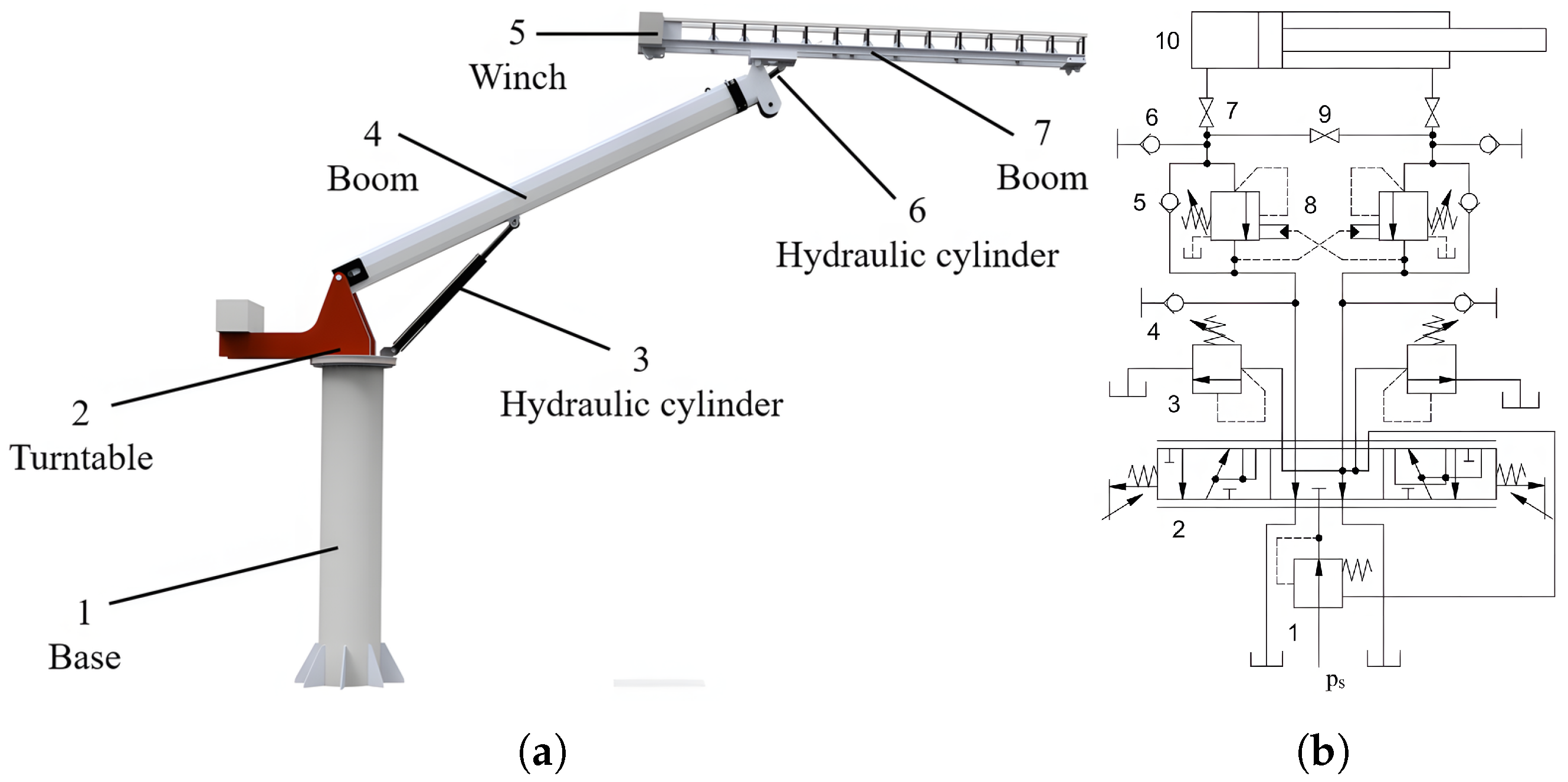
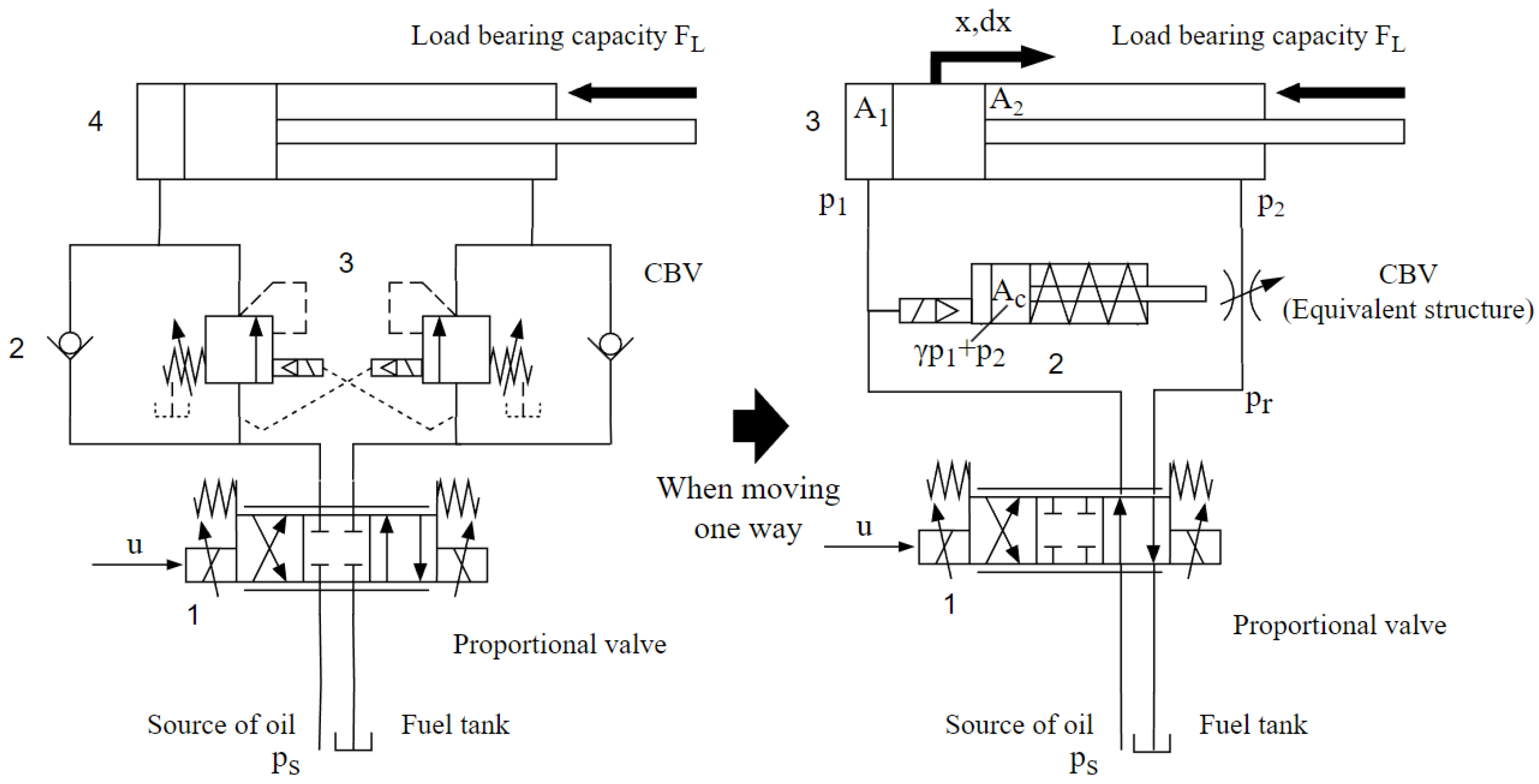
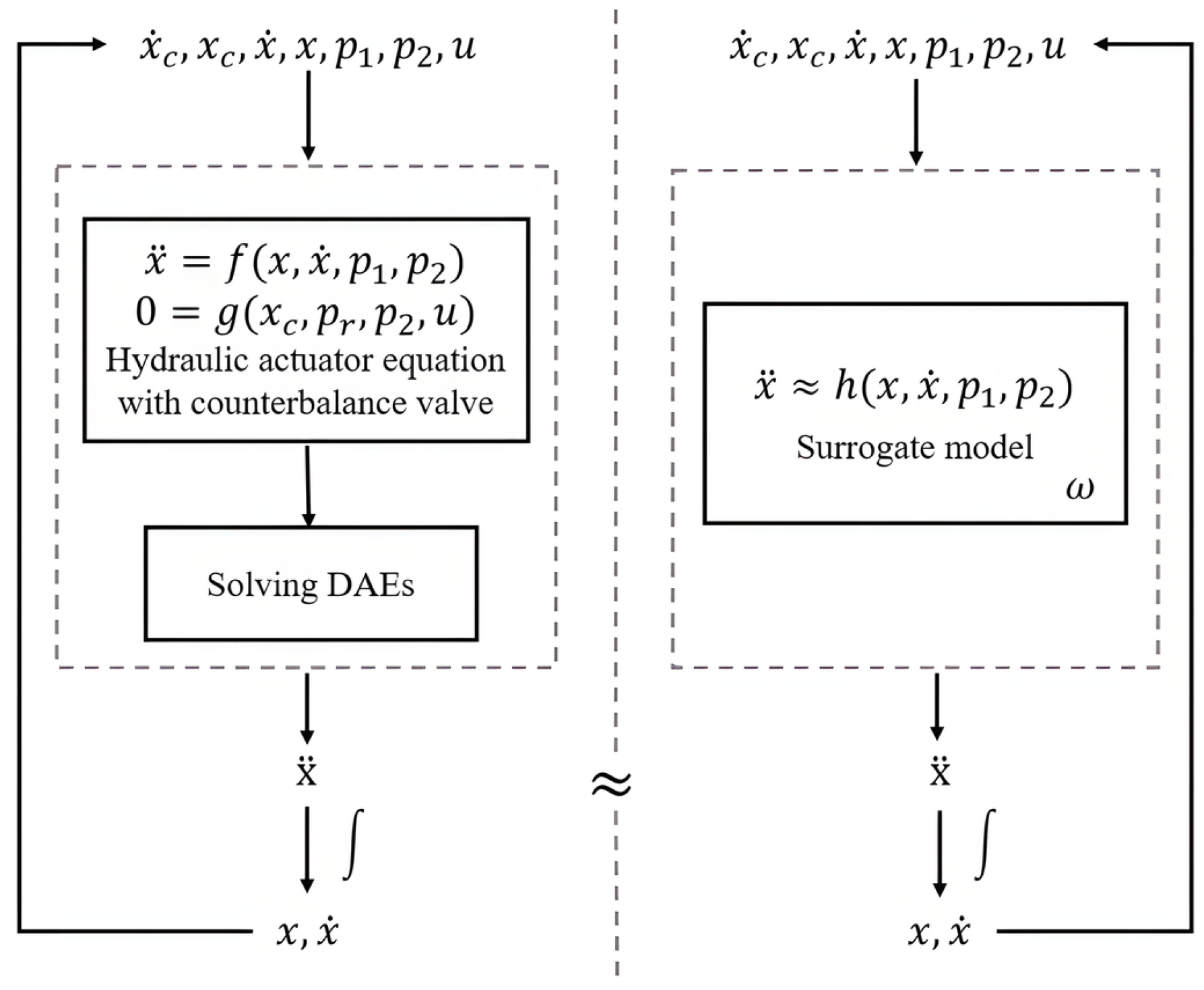
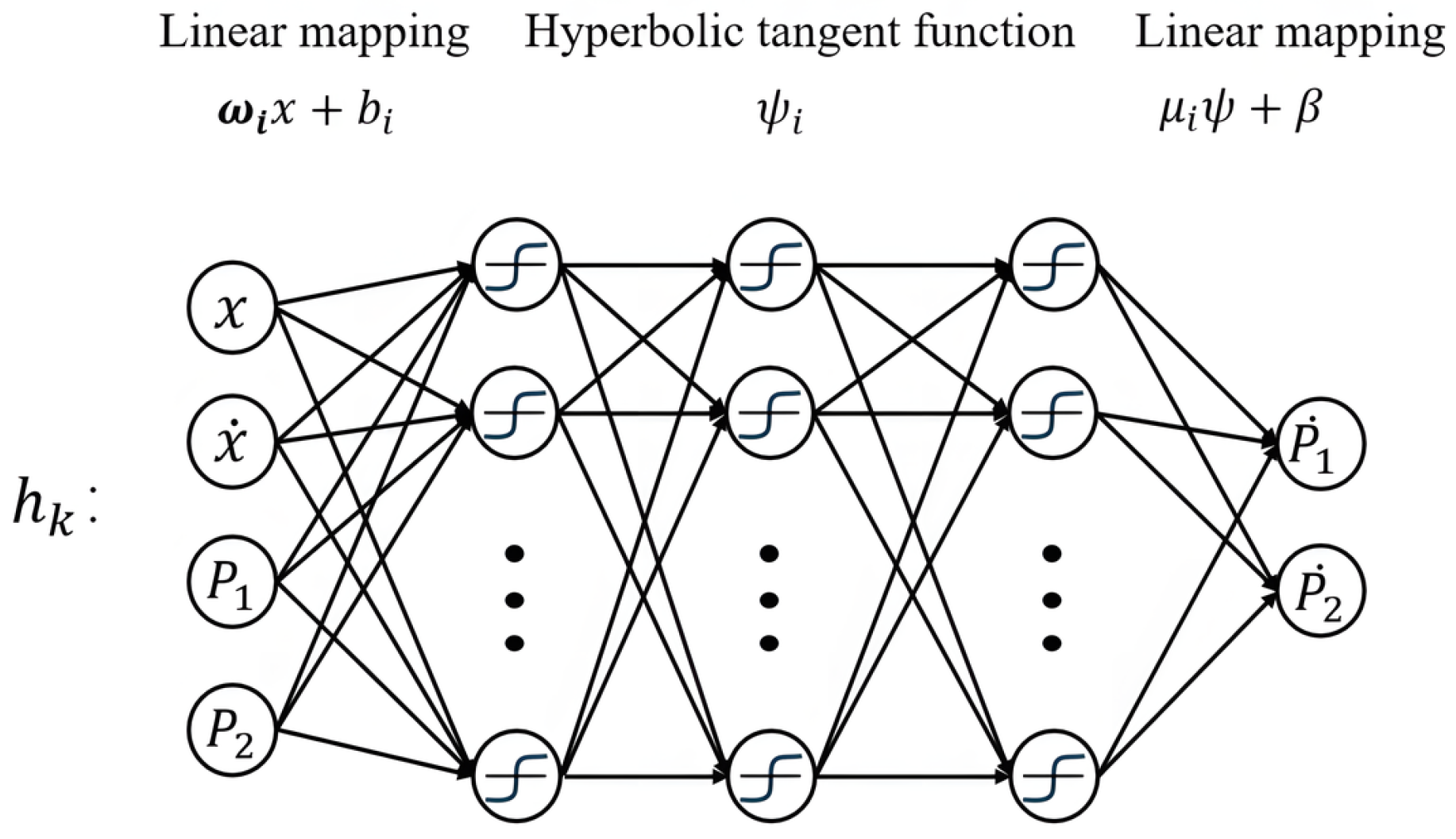


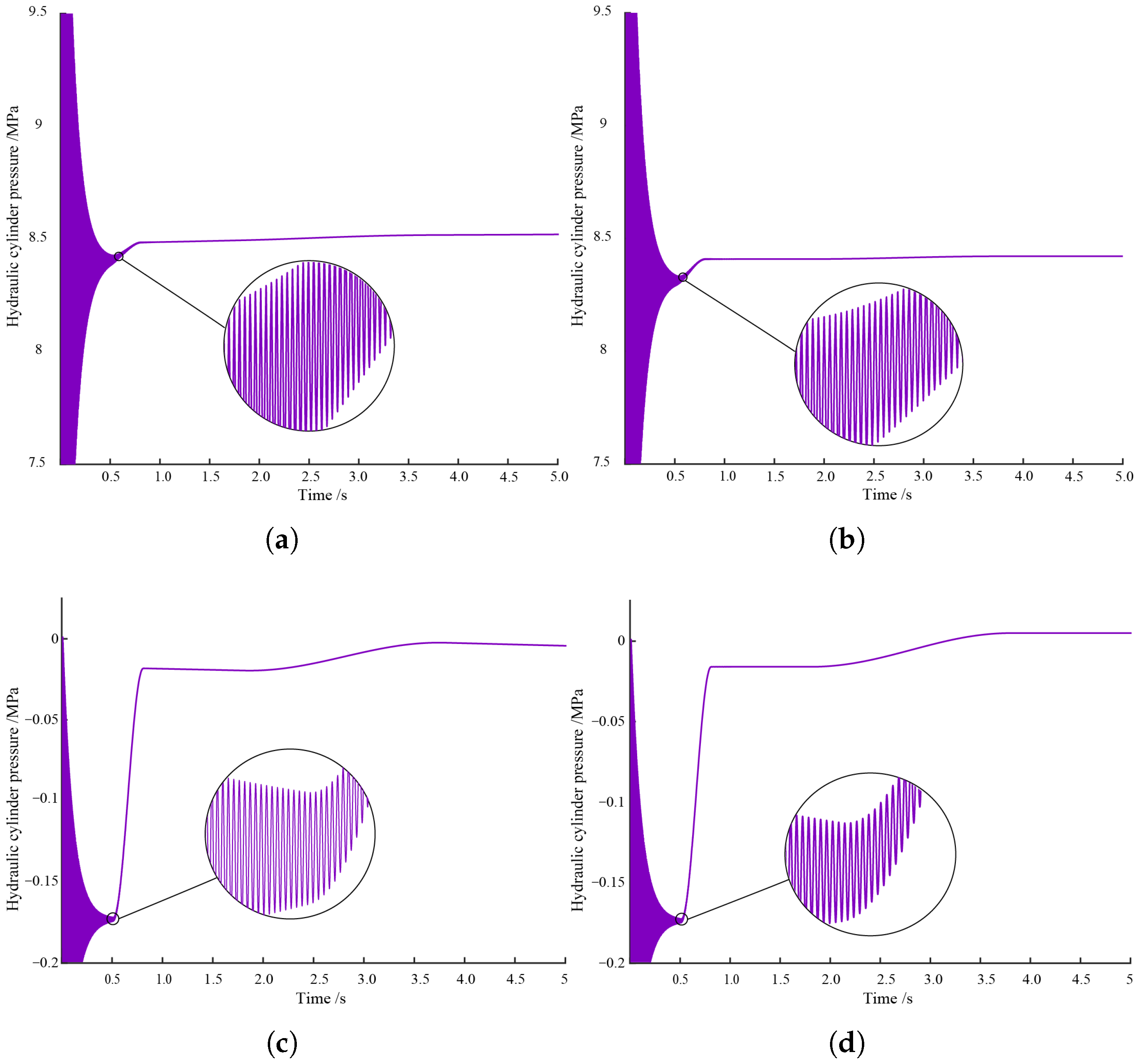

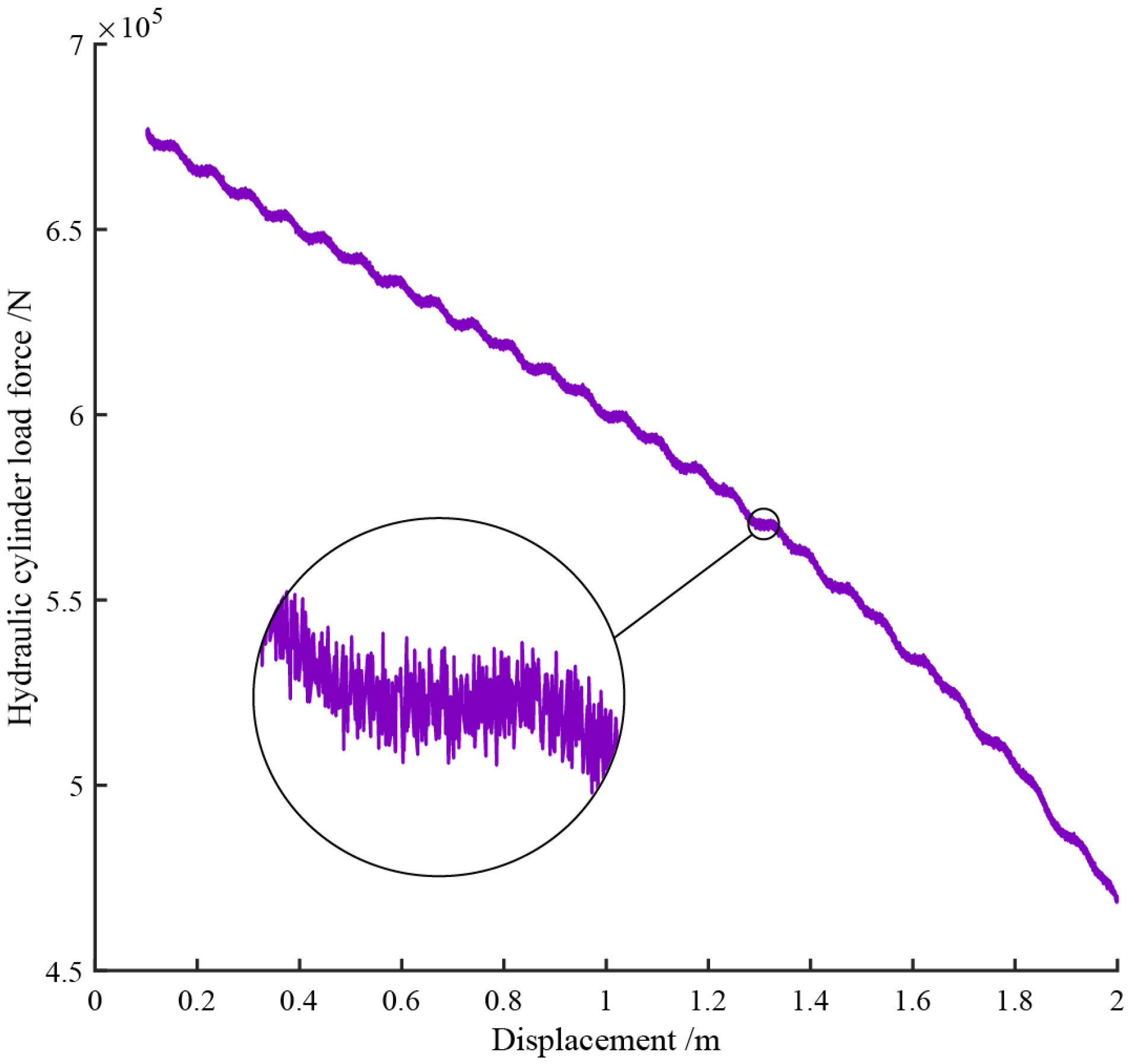
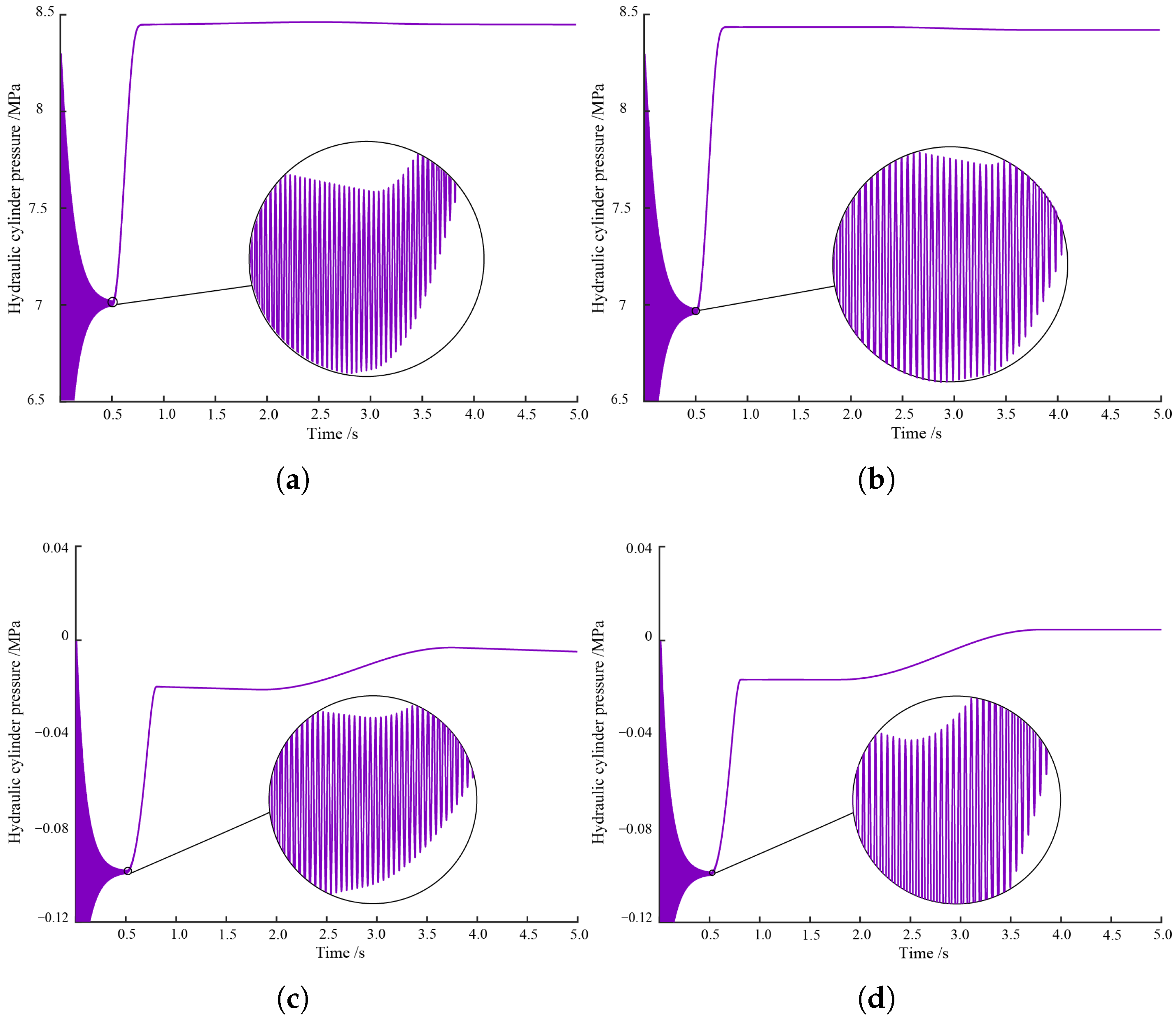

| Model Parameters (Units) | Value |
|---|---|
| M (kg) | 200 |
| () | 0.025 |
| C () | 1 |
| () | 0.1 |
| () | 80,424.8 |
| () | 49,008.8 |
| () | 23.94 |
| () | |
| () | |
| (MPa) | 30 |
| 4.5 | |
| (MPa) | 1.7 |
| () | 5 |
| (MPa) | 690 |
| () | 20 |
| () | 20 |
| Parameters | Minimum Value | Maximum Value |
|---|---|---|
| 0 | 2000 | |
| 1000 | ||
| 1 |
| Normalized Absolute Error | Training Iterations | Total Training Duration |
|---|---|---|
| 1537 | 20 h 11 min |
| Category | ||
|---|---|---|
| error absolute value | 0.1001 | 0.0093 |
| Category | ||
|---|---|---|
| error absolute value | 0.0402 | 0.0099 |
| Model Type | Computation Time (ms) |
|---|---|
| First-Principle Model | 4.3103 |
| Surrogate Model | 0.2011 |
| Model Type | Memory Consumption (MB) |
|---|---|
| First-Principle Model | 334.35 |
| Surrogate Model | 206.09 |
Disclaimer/Publisher’s Note: The statements, opinions and data contained in all publications are solely those of the individual author(s) and contributor(s) and not of MDPI and/or the editor(s). MDPI and/or the editor(s) disclaim responsibility for any injury to people or property resulting from any ideas, methods, instructions or products referred to in the content. |
© 2025 by the authors. Licensee MDPI, Basel, Switzerland. This article is an open access article distributed under the terms and conditions of the Creative Commons Attribution (CC BY) license (https://creativecommons.org/licenses/by/4.0/).
Share and Cite
Xu, L.; Nie, H.; Cheng, X.; Wei, Q.; Chen, H.; Tao, J. Surrogate Model of Hydraulic Actuator for Active Motion Compensation Hydraulic Crane. Electronics 2025, 14, 2678. https://doi.org/10.3390/electronics14132678
Xu L, Nie H, Cheng X, Wei Q, Chen H, Tao J. Surrogate Model of Hydraulic Actuator for Active Motion Compensation Hydraulic Crane. Electronics. 2025; 14(13):2678. https://doi.org/10.3390/electronics14132678
Chicago/Turabian StyleXu, Lin, Hongyu Nie, Xiangyang Cheng, Qi Wei, Hongyu Chen, and Jianfeng Tao. 2025. "Surrogate Model of Hydraulic Actuator for Active Motion Compensation Hydraulic Crane" Electronics 14, no. 13: 2678. https://doi.org/10.3390/electronics14132678
APA StyleXu, L., Nie, H., Cheng, X., Wei, Q., Chen, H., & Tao, J. (2025). Surrogate Model of Hydraulic Actuator for Active Motion Compensation Hydraulic Crane. Electronics, 14(13), 2678. https://doi.org/10.3390/electronics14132678






